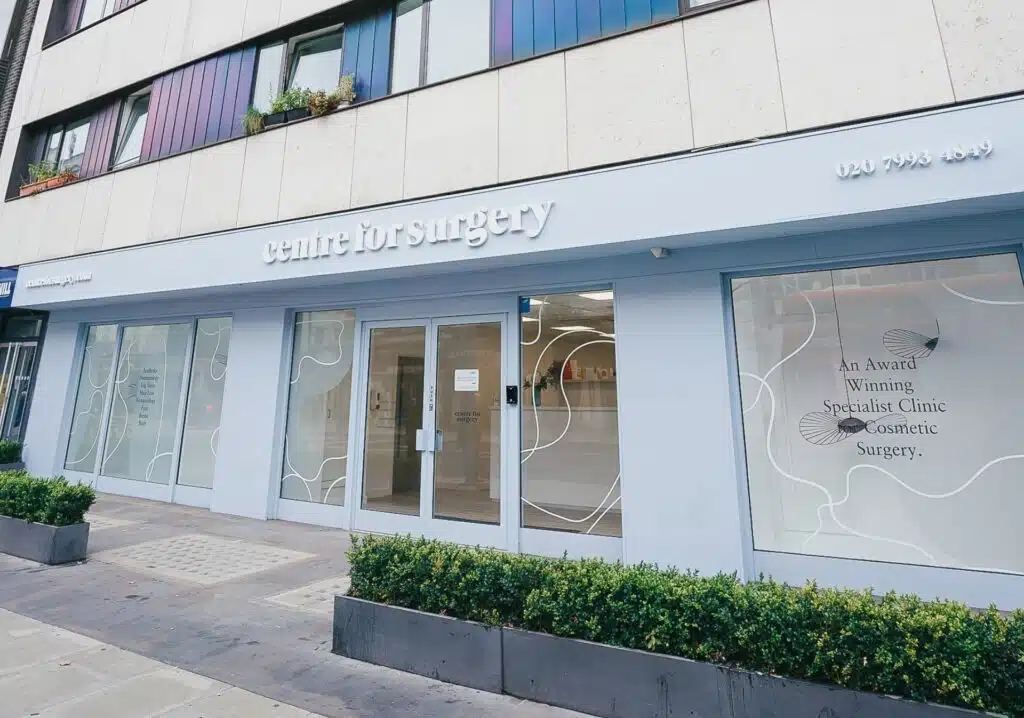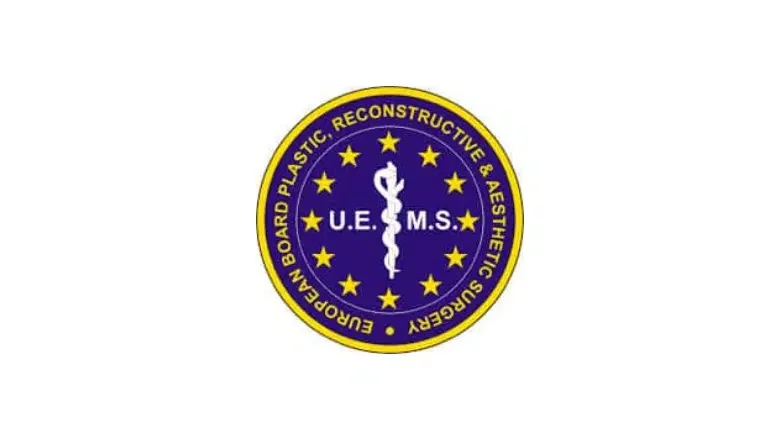What Are the Different Types of Noses and Surgical Options to Correct them?
There is a wide variety of nose sizes and shapes, with each person’s nose possessing unique features. For patients unhappy with their nose looks, rhinoplasty, also known as a nose job, is a highly effective surgical procedure for nose reshaping. Many people may already have noticed certain features of their nose that they are unhappy with, and when carrying out online research about rhinoplasty, they may have a better idea of which aspects of their nose they would like to change.
RELATED: Nose Surgery
Our rhinoplasty surgeons are some of the most experienced rhinoplasty experts in London, and the type of surgery required will depend on your nose shape. There are various types of noses based on shape, size, and other characteristics. Identifying your nose type can help you understand which nose surgery might be most suitable for you. Here are some common nose types.
Different nose shapes – What type of nose do you have?
Greek nose (Straight nose)
Greek noses are also known as straight noses, as the most characteristic feature is the straight nasal dorsum or bridge and nostrils with a narrower appearance. Many patients view Greek noses as a highly desirable nose shape as there is often a lack of bumps on the nasal dorsum, which is the most popular nose shape requested by our patients. Some patients with straight noses choose to have a rhinoplasty procedure if they feel the size of their nose is too large or to reduce the prominence of the nasal tip to improve balance with the rest of their facial features.
Roman nose (Aquiline nose)
Roman noses have an excessively prominent nasal bridge that may deviate slightly at the tip of the nose. Patients with a Roman nose have rhinoplasty surgery to improve tip projection and remove prominent dorsal humps found on the bridge of the nose. Many men find a Roman nose highly desirable, and it is the most commonly requested nose shape by men. Well-known celebrities who have a Roman nose include Tom Cruise and Ryan Gosling.
RELATED: Aquiline Nose Surgery – Can Rhinoplasty Correct a Hooked or Crooked Nose?
Hawk nose
Hawk nose shapes commonly resemble the form of a Roman nose; however, a hawk nose has a narrower nasal bridge and a pointy nasal tip. These types of noses often have a prominent curvature which gives the impression of a hooked appearance similar to a hawk’s beak. Many patients see this as an undesirable nose shape. Rhinoplasty surgery is effective for straightening the nose and smoothening the nasal contour. The actor Adrien Brody is one of the most famous people who has a hawk-type nose shape.
Button nose (Snub nose)
A button nose is also known as a snub nose and has similar characteristics to an upturned nose, although snub noses tend to be rounder in shape with an upturned component so that the nostrils are more visible when viewed front on. It can give the face a youthful and friendly appearance. Patients who have a button nose most commonly have a rhinoplasty to lower the nasal tip and increase the length of the nose. Examples of celebrities who have button noses include Wayne Rooney and Elizabeth Taylor.
Nubian nose (African nose)
Nubian nose shapes are most commonly seen in patients of African backgrounds. The characteristic features of a Nubian nose include a broad base, a long nasal bridge and a nose tip which often projects downwards towards the lips. Patients of African descent who have Nubian noses most commonly have rhinoplasty surgery to reduce the width of the nose as part of an ethnic rhinoplasty procedure. Former US President Barack Obama and Beyoncé have Nubian nose shapes. Surgeons at Centre for Surgery specialise in African rhinoplasty.
RELATED: African Rhinoplasty
Wide nose
A wide nose is characterised by a broad nasal bridge, wide nostrils, or a large and rounded nasal tip. This type of nose may appear disproportionate to other facial features, and individuals with a wide nose may seek to refine its shape for aesthetic or functional reasons. The width of the nose can be attributed to various factors, such as:
- Genetics: A wide nose can be a hereditary trait passed down through generations. Ethnic background plays a significant role in determining the shape and size of the nose, with certain groups having a predisposition for a wider nose.
- Ageing: As we age, the skin loses elasticity, and the underlying facial structures shift, which can lead to a wider or more prominent nose.
- Trauma or injury: A past injury to the nose can result in a wider appearance, particularly if the nasal bones or cartilage were damaged or healed improperly.
Long nose
An elongated nasal bridge, an extended nasal tip, or both characterise a long nose. This type of nose may appear disproportionate to other facial features and can make a face seem imbalanced.
Celestial nose (Upturned nose)
The upturned nose usually has a small size, and the tip of the nose projects upwards. Celestial nose shapes most commonly have a slight depression located on the middle part of the dorsum of the nose. This is a commonly requested nose shape for many patients who come to see us. However, some patients may have a significantly upward nasal tip rotation that results in a significant curve, which may be a source of distress for any patients that wish to have this corrected.
SEE ALSO: How long does swelling last after a Rhinoplasty?
Bumpy nose
A bumpy nose, also referred to as a dorsal hump or nasal hump, is characterised by an uneven or irregular bridge that creates a protrusion or bump on the profile of the nose. This bump is usually more noticeable from the side view.
RELATED: Dorsal Hump – Causes of Nose Bumps & Removal Options
For individuals seeking to address a bumpy nose, rhinoplasty is the most common surgical procedure. During rhinoplasty, the surgeon removes or reshapes the nasal bone and cartilage responsible for the bump, creating a smoother and more aesthetically pleasing nasal profile.
Crooked nose
A crooked nose most commonly develops due to previous traumatic injury to the nose from contact sports such as rugby. In some cases, a crooked nose may develop from birth due to the influence of hereditary factors, including the excessive proliferation of the cartilaginous framework of the nose. A crooked nose often appears deviated when viewed from the front or may have prominent and visible bumps. Crooked nose correction is a complex type of rhinoplasty procedure that uses reconstructive techniques. This type of rhinoplasty is only carried out by expert rhinoplasty surgeons who regularly perform reconstructive surgery on the nose. Celebrities who have bumpy or crooked noses include Clive Owen and Owen Wilson.
Bulbous nose (Bulbous nose tip)
A bulbous nose has a rounded and enlarged appearance of the nasal tip, which often results in the tip of the nose looking out of balance with the rest of the nasal features due to a lack of definition. Bulbous nose surgery involves reducing the tip of the nose by removing excess cartilage and accurately reshaping the cartilage remaining with sutures for precise correction. Some people may develop a bulbous nose due to a skin condition referred to as rhinophyma. Chronic untreated rosacea can result in the development of rhinophyma. Rhinoplasty is not the correct treatment for this condition. Rhinophyma is the excessive proliferation of the soft tissue surrounding the nasal framework and is not related to the underlying nasal framework itself. The best treatment would be CO2 or Erbium laser for precise reshaping of the rhinophyma nose. Well-known public personalities who have bulbous noses include former US President Bill Clinton.
RELATED: What is a Bulbous Nose? – Nose Surgery Options
Fleshy nose
Fleshy noses are most commonly seen in men, and the most characteristic features are a large and wide nose with a prominent nasal projection. Many patients seek rhinoplasty surgery for a fleshy nose to reduce the width of the sides of the nose and narrow the tip to give an increased tip definition. Well-known people who have fleshy noses include Mark Ruffalo and Albert Einstein.
SEE ALSO: Ultrasonic Rhinoplasty
East Asian nose
The East Asian nose is a term used to describe the nose shape commonly seen among people of East Asian descent, such as those from China, Japan, Korea, and Mongolia. While there is considerable variation in nose shapes within this population, some common characteristics of the East Asian nose include the following:
- Low and flat nasal bridge: The nasal bridge is typically less prominent and flatter compared to other ethnic groups. This feature can create a softer profile and make the nose appear shorter.
- Wide and rounded nasal tip: The tip of the East Asian nose is often round or bulbous and may lack definition or projection.
- Wider nostrils: The nostrils of an East Asian nose can appear wider and more flared than those seen in other ethnic groups.
- Thicker skin: The skin on the nose of East Asian individuals tends to be thicker, which can contribute to a less-defined nasal tip and an overall wider appearance.
Can your nose shape be changed?
Rhinoplasty is the best procedure for altering the size and shape of the nose. Our expert rhinoplasty surgeons have years of experience working with patients to achieve the ideal nose shape using cutting-edge surgical techniques. As with all types of cosmetic surgery, it is essential to have realistic expectations of what the surgery can achieve. For patients who are not yet keen on a permanent rhinoplasty procedure, the option of a non-surgical rhinoplasty or nose thread lift could be appropriate. These treatments can often be used as testers to see if patients are happy with their new shape. Non-surgical rhinoplasty is a temporary procedure with results lasting no more than 18 months. The procedure can reshape the nose and add volume in certain areas to reduce the appearance of any localised lumps and bumps. Once they are happy, they can then proceed with a surgical rhinoplasty for a permanent and long-term fix.
Nose Surgery Procedures for Problems with Different Types of Noses
Nose surgeries can be performed for both cosmetic and functional reasons, addressing various issues with different types of noses. Here’s a closer look at these popular procedures:
- Rhinoplasty: Also known as a “nose job,” rhinoplasty is a surgical procedure that reshapes and straightens the nose for aesthetic or functional purposes. It can address issues such as a crooked nose, a prominent nasal hump, or an asymmetrical nasal tip. This surgery can improve the overall appearance of the nose and, in some cases, help alleviate breathing problems.
- Tip Rhinoplasty: This specialised form of rhinoplasty focuses on the nasal tip. The procedure can refine and contour the end of the nose, correct a drooping or upturned tip, or improve a bulbous or boxy nasal tip. It’s often performed to achieve a more harmonious appearance between the nasal tip and the rest of the nose.
- Alarplasty: Also known as nostril reduction or alar base reduction, alarplasty is a procedure that narrows wide nostrils or reduces nasal flare. It involves removing a small wedge of tissue from the base of the nostrils, resulting in a more balanced and aesthetically pleasing appearance. This surgery can be performed in conjunction with other nasal procedures or as a standalone procedure.
- Septoplasty: A septoplasty is a surgical procedure that corrects a deviated septum, which is the cartilage and bone dividing the nasal cavity into two separate chambers. A deviated septum can cause difficulty breathing, frequent sinus infections, and even snoring. Septoplasty straightens the septum, allowing for improved airflow and breathing.
- Turbinoplasty: Turbinates are small, bony structures within the nasal passages that help humidify and filter the air we breathe. If the turbinates become enlarged or swollen, they can obstruct airflow and cause breathing difficulties. A turbinoplasty, also known as turbinate reduction, is a surgical procedure that reduces the size of the turbinates to improve the airway and breathing. This procedure can be performed alongside a septoplasty or other nasal surgeries to address multiple breathing issues simultaneously.
RELATED: Nose Surgery FAQs – Q&As about Rhinoplasty
Rhinoplasty Procedures for Different Nose Shapes
With a grasp of different nose types and nose surgery, we can delve deeper into the subject.
Rhinoplasty, the most common nose surgery, comprises four primary types:
Reduction Rhinoplasty
Patients seeking to decrease their nose size often choose this procedure.
During this surgery, the surgeon works to diminish the patient’s overall nose size, focusing on specific areas such as bumps, humps, or the nose tip. The cartilage, bone, or both may be reduced to achieve the desired nose shape and customised appearance. This procedure is ideal for those with an exceptionally long nose.
Post-Traumatic Rhinoplasty
Surgery may be required for patients who have experienced accidents or injuries that affected their nose, helping them regain a normal nose shape. Recovery time depends on the extent of the damage and the number of surgical procedures needed. Some patients may also opt for cosmetic enhancements during this process. The operation restores or reshapes the nose’s symmetry if the cartilage or bones are displaced and addresses breathing difficulties, snoring, blockages, or other functional issues.
RELATED: Broken Nose Surgery – Break Your Nose?
Augmentation Rhinoplasty
This surgery is suitable for patients with a significantly small nose, which may result from genetic factors or damaged cartilage.
Augmentation nasal surgery enhances the overall dimensions of the nose, catering to patients with a reduced nasal height due to congenital defects, trauma, infection, excessive reduction rhinoplasty, or submucosal resection. The surgeon may use the patient’s cartilage or a synthetic nasal implant to augment and enlarge the nose during the procedure.
Corrective Rhinoplasty or Revision Rhinoplasty
Patients dissatisfied with the results of their initial nose surgery may undergo revision rhinoplasty, commonly referred to as secondary or even tertiary nose surgery. It primarily rectifies issues or imperfections that occurred post-surgery.
The surgery may involve augmentation or reduction procedures. However, the primary objective is to restore the nose’s anatomy and address potential breathing problems. Common nose concerns requiring corrective rhinoplasty include:
- Over-reduction or insufficient reduction of bridge height
- Nasal airway obstruction
- Worsened nose asymmetry
- Overdone nose job
- Excessive or insufficient tip projection
- Inadequate shaping
- Thickened scar tissue
Reconstructive Rhinoplasty
Often performed for medical reasons, this procedure restores damaged or lost tissue resulting from cancer treatment, accidents, or injuries. In some cases, nose tissue may need removal for other reasons, and this surgery can help rectify the issue.
The rhinoplasty surgeon employs cartilage grafts from other body parts to replace damaged or lost tissue during reconstructive rhinoplasty. This complex procedure may necessitate multiple surgeries and several months to achieve the desired outcome.
Refinement Rhinoplasty
This procedure reshapes the nose tip for patients desiring a sharper, pointier nose or enhancing the nose’s roundness. The surgery can also adjust the nose tip to point upwards or downwards. Refinement rhinoplasty focuses on this crucial nose aspect, dramatically altering one’s facial appearance.
Is rhinoplasty a major surgery?
Rhinoplasty, also known as a nose job, is considered a significant surgical procedure, but whether it’s classified as major surgery can depend on the extent of the procedure and the specific changes being made to the nose. Rhinoplasty can be performed for aesthetic purposes, functional reasons, or both, and involves reshaping the nasal bones, cartilage, and/or soft tissues to achieve the desired outcome.
Rhinoplasty is typically performed under general anaesthesia or local anaesthesia with sedation, and it can be done using either an open or closed approach. In the open approach, a small incision is made across the columella (the tissue separating the nostrils), giving the surgeon better visibility and access to the nasal structures. In the closed approach, all incisions are made within the nostrils, resulting in no visible scarring.
The surgery can last anywhere from one to three hours, depending on the complexity of the procedure. As with any surgery, there are risks and potential complications associated with rhinoplasty, including infection, bleeding, anaesthesia complications, and unfavourable cosmetic results.
Recovery from rhinoplasty typically takes several weeks, with most patients able to return to work or school within 1-2 weeks. Swelling and bruising are common and can take several months to fully subside.
How to make your nose smaller?
Reducing the nose size is one of the most common reasons for patients to have a rhinoplasty procedure. This type of rhinoplasty is known as a reduction rhinoplasty. It is designed to reduce the overall size of the nose or surgically reshape the nasal tip to make it appear smaller. When you have your rhinoplasty consultation, the surgeon will design the optimal treatment plan to fit your needs and preferences. Rhinoplasty surgery typically involves the removal of cartilage and bone to make the nose appear smaller and in better balance with the rest of your facial features.
RELATED: What Nose Shape Concerns Can Rhinoplasty Correct?
What is the most popular nose shape?
Everyone is different, and noses are unique to an individual. What works for one patient may appear significantly different for another patient. The ideal size and shape of the nose are noses in proportion to the rest of your facial features. Generally, the most commonly requested type of nose shape is the Greek nose, which is probably due to the straighter contours. It is essential to bear in mind that the best noses are tailored to the individual patient. While photos of celebrities can be helpful, these should only be used as a rough guide for what can be achieved with rhinoplasty surgery.
Rhinoplasty before and after results
Case 1:



Case 2:

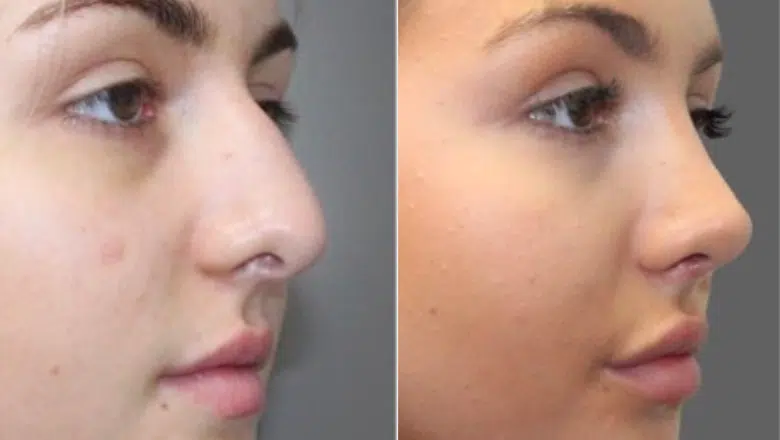
Case 3:



Case 4:




Case 5:
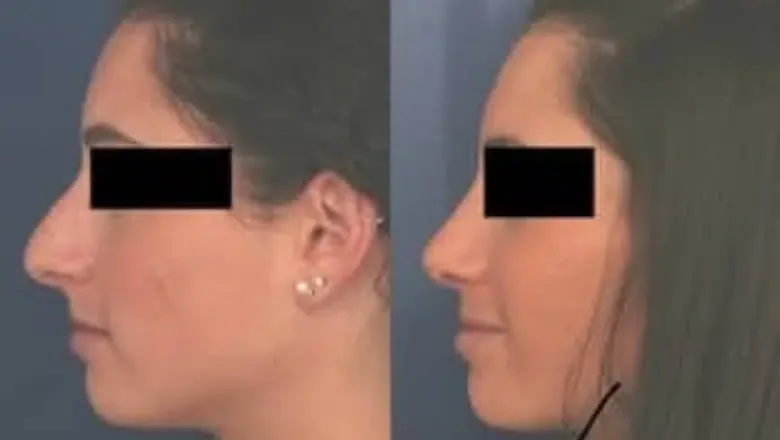
Case 6:


Case 7:
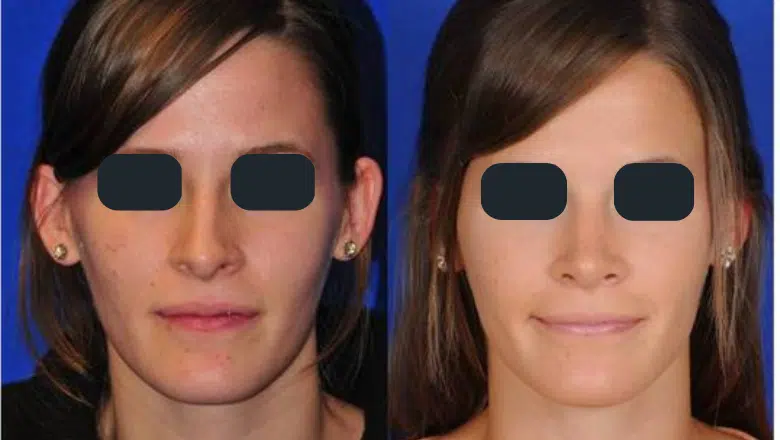

Case 8:

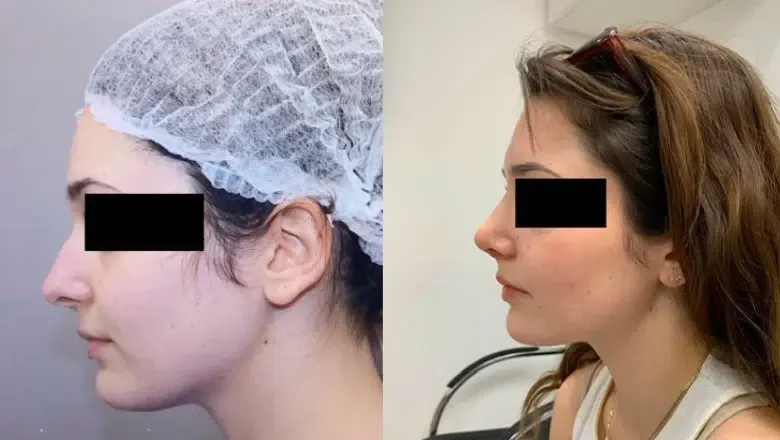

Case 10:


Case 11:

Case 12:

FAQs about Type of Noses and Rhinoplasty
What types of noses are there?
There are various nose shapes, and while each nose is unique, some common types include the fleshy nose, hawk nose, bulbous nose, and aquiline nose.
Which nose shape is most common?
From the data in a particular journal article, it seems the fleshy nose is the most prevalent (almost 25%), followed by the hawk nose at 5%.
What types of noses are most desirable?
Beauty standards vary across cultures and eras. In certain cultures, a smaller nose is seen as desirable because it appears delicate and feminine. However, others might appreciate a strong and pronounced nose. Personal preferences play a significant role in such perceptions.
RELATED: What is The Ideal Nose?
What is the most common nose shape for rhinoplasty?
The frequent request for rhinoplasty is to have a nose that looks refined and smaller. This often means reshaping the nose bridge and reducing nostril size. However, our surgeons emphasise that each patient is unique. Hence, they create a tailored rhinoplasty plan that seeks harmony, balance, and proportion for the individual’s face.
Can nose shape indicate character?
Historical and cultural beliefs have associated the nose with insights into a person’s intellect, emotional capacities, and even their love capabilities. But, it’s crucial to understand that these are myths and stereotypes. Every individual is unique.
Rhinoplasty surgery at Centre for Surgery
At Centre for Surgery, we understand that each patient is unique, and we are committed to providing personalised care tailored to your individual needs and goals. Our experienced and board-certified surgeons take the time to listen to your concerns, answer your questions, and guide you through the entire process to ensure you feel comfortable and confident in your decision to undergo a cosmetic or reconstructive procedure.
We recognise that optimal results can only be achieved through a combination of careful planning, state-of-the-art surgical techniques, and a deep understanding of each patient’s unique anatomy and aesthetic goals. Our surgeons are dedicated to helping you achieve the best possible outcome while minimising risks and ensuring a smooth recovery.
From the initial consultation to postoperative care, we pride ourselves on our one-on-one service and attention to detail. We have helped thousands of women and men from the London area and across the UK achieve the aesthetic results they desire, enhancing their confidence and improving their quality of life.
At Centre for Surgery, our mission is to provide an exceptional level of care and support to our patients, ensuring that they feel well-informed, safe, and satisfied throughout their entire surgical journey. We strive to build lasting relationships with our patients and help them achieve their desired aesthetic outcomes in a compassionate and professional environment.
- All-inclusive rhinoplasty cost with no hidden extras
- Your very dedicated patient coordinator will act as your point of contact throughout all stages of your rhinoplasty journey with us
- Our rhinoplasty surgeons have trained at some of the world’s leading centres for rhinoplasty surgery, including Istanbul, New York and Australia
- Our postoperative nursing team takes a proactive approach to monitoring your progress during the rhinoplasty recovery period
- We are contactable 24 hours a day, seven days a week, for any questions or concerns you may have after you have had your rhinoplasty procedure
- We are committed to achieving high standards of medical care both before, during and after your procedure
Please get in touch with us today to book a face-to-face consultation with an expert rhinoplasty surgeon in London at our advanced day surgery facility in Marylebone, central London.




